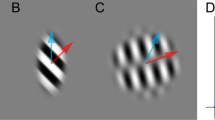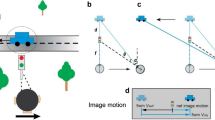Abstract
Information on motion is important for the determination of the three-dimensional (3-D) structure of the environment for both human and non-human primates1–8. For example, if a person were to close one eye and look at an evenly illuminated, irregularly shaped object, he would be unlikely to guess its shape correctly. But if the object is moved about, the correct shape immediately becomes apparent9. Little is known about how the primate visual system actually does this, although various theories have been proposed7,8,10–15. We have developed novel, highly controlled motion stimuli to use with psychophysical and physiological techniques to study how 3-D structure is obtained from motion. We show that the Rhesus monkey can detect 3-D structure from motion in the same way as human subjects. Furthermore, the dependence of both species on certain parameters of the display shows that information is integrated both spatially and temporally for this higher visual function.
This is a preview of subscription content, access via your institution
Access options
Subscribe to this journal
Receive 51 print issues and online access
$199.00 per year
only $3.90 per issue
Buy this article
- Purchase on Springer Link
- Instant access to full article PDF
Prices may be subject to local taxes which are calculated during checkout
Similar content being viewed by others
References
Wallach, H. & O'Connell, D. N. J. exp. Psychol. 45, 205–217 (1953).
Braunstein, M. L. J. exp. Psychol. 64, 415–420 (1962).
van Hooff, J. A. R. A. M. in Primate Ethology (ed. Morris, D.) 7–66 (Weidenfeld & Nicolson, London, 1967).
Bertrand, M. Bibliotheca primatologica 11 (Karger, Basel, 1969).
Shepard, R. N. & Judd, S. Science 191, 952–954 (1976).
Lappin, J. S., Doner, J. F. & Kottas, B. L. Science 209, 717–719 (1980).
Zucker, S. W. in Figural Synthesis (eds Dodwell, P. C. & Caellli, T.) 283–300 (Erlbaum, London, 1984).
Zucker, S. W. & Iverson, L. McGill University: Computer Vision and Robotics Technical Report 8-8 (1986).
von Helmholtz, H. in Treatise on Physiological Optics (ed. Southall, J. P. C.) p. 297 (Dover, New York, 1962).
Gibson, J. J., Olun, P. & Rosenblatt, F. Am. J. Psychol. 68, 372–385 (1955).
Gibson, J. J. & Gibson, E. J. J. exp. Psychol. 54, 129–138 (1957).
Longuet-Higgins, H. C. & Prazdny, K. Proc. R. Soc. B208, 385–397 (1980).
Marr, D. in Vision (Freeman, New York, 1982).
Ullman, S. in The Interpretation of Visual Motion (M.I.T. Press, Cambridge, 1979).
Ullman, S. Perception 13, 255–274 (1984).
Golomb, B., Andersen, R. A., Nakayama, K., MacLeod, D. I. & Wong, A. Vision Res. 25, 813–820 (1985).
Morgan, M. J. & Ward, R. Qu. J. exp. Psych. 32, 387–395, (1980).
Author information
Authors and Affiliations
Rights and permissions
About this article
Cite this article
Siegel, R., Andersen, R. Perception of three-dimensional structure from motion in monkey and man. Nature 331, 259–261 (1988). https://doi.org/10.1038/331259a0
Received:
Accepted:
Issue Date:
DOI: https://doi.org/10.1038/331259a0
This article is cited by
-
Preference for biological motion is reduced in ASD: implications for clinical trials and the search for biomarkers
Molecular Autism (2021)
-
Changes in low-level neural properties underlie age-dependent visual decision making
Scientific Reports (2018)
-
Discrimination of movement and visual transfer abilities in cichlids (Pseudotropheus zebra)
Behavioral Ecology and Sociobiology (2018)
-
Perception and discrimination of movement and biological motion patterns in fish
Animal Cognition (2015)
-
Mom’s shadow: structure-from-motion in newly hatched chicks as revealed by an imprinting procedure
Animal Cognition (2009)
Comments
By submitting a comment you agree to abide by our Terms and Community Guidelines. If you find something abusive or that does not comply with our terms or guidelines please flag it as inappropriate.



